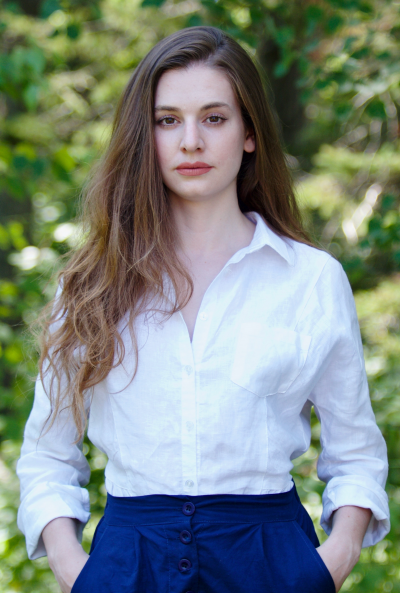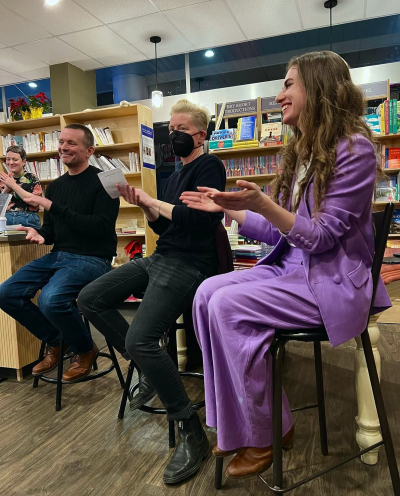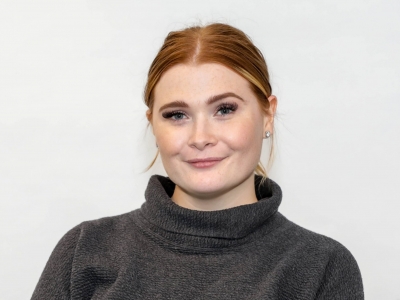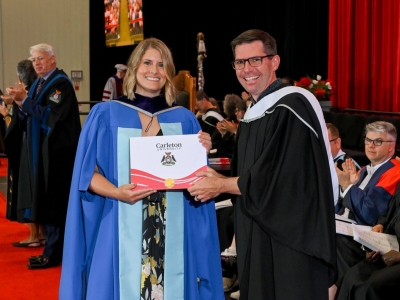Dr. Siobhan Angus (Assistant Professor – Communication & Media Studies) discusses her book Camera Geologica, the joys of working at the intersection of different disciplines, and the links between her work as curator, organizer, and academic.
By Jaime Sadgrove
 Siobhan Angus is an Assistant Professor of Communication and Media Studies in Carleton’s School of Journalism and Communication, having joined the faculty in 2022. In talking to her about her work, which brings together art history, media studies, and environmental humanities, it quickly becomes clear that for her, what is unseen and unsaid is more interesting than what’s on the surface.
Siobhan Angus is an Assistant Professor of Communication and Media Studies in Carleton’s School of Journalism and Communication, having joined the faculty in 2022. In talking to her about her work, which brings together art history, media studies, and environmental humanities, it quickly becomes clear that for her, what is unseen and unsaid is more interesting than what’s on the surface.
While spending two years at Yale University as the Banting Postdoctoral Fellow in the History of Art, Siobhan turned her attention to the history of photography. With a focus on materiality and the resource extraction necessary for photography as an art form, this analysis feels different to how photography as an art form is typically discussed and critiqued. Siobhan says, however, that this is not a new path of inquiry – simply one that has not been mainstream for several decades.
“When you read photography journals from the 19th century, they talk about raw materials and mining,” Siobhan said. “This history is sort of painfully obvious […] but we tend to skip over it.” She explained that this connection is as deep as the language we use to talk about photography, and, by extension, cinema: the term silver screen, used commonly as a figure of speech for the movie industry, refers to the use of silver in the manufacture of early projection screens.

Camera Geologica by Siobhan Angus (2024)
This path of inquiry became Camera Geologica: An Elemental History of Photography, which was published at the beginning of April by Duke University Press. Camera Geologica charts the history of photography through six different material resources (bitumen, silver, platinum, iron, uranium, and rare earth elements) across the 19th and 21st centuries and makes the case that although the creation of photography would be impossible without mining, the way we think and talk about that art form intentionally erases the necessity of those materials.
Siobhan’s work in Camera Geologica is designed to challenge the notion of photography as weightless and effortless. “Light is important to photography, but it’s only part of the story,” Siobhan said. “Photography is literally light written in metal”, she says, so issues of resource extraction are, necessarily, issues of artistic critique.
While Siobhan’s research focuses on bringing materials into the conversation, that’s not her only priority. Discourses about art often erase labour, and so Siobhan wants to centre the importance of human effort to photographic creation – but not just the labour of the photography. “Rob Nixon says capitalism extracts in order to extract – that we separate workers by their discipline to say their labour has nothing in common with each other.” Siobhan went on to say that process of extraction mirror each other, whether extracting resources from the earth or labour from workers. Asked how photographers should think about the extraction their work requires, Siobhan says “I don’t think anyone should stop making photos [….] but that thinking is an invitation to solidarity and collectivity”.
Siobhan also said photographers are not the only ones who should be thinking more about the role of extraction. As a Canadian researcher, she said she feels a responsibility to reckon with extraction as an aspect of our national identity and economy. “Seventy-five percent of all the mining companies in the world are headquartered in Canada. The Toronto Stock Exchange is the primary funder of extractive projects.” Siobhan said. “We can’t just say ‘oh, that’s Alberta’ because the funding comes from across the country. Canada has a long history of resource extraction and it shapes our culture and politics in profound ways.” The entry into discussion of resource extraction in Camera Geologica is an examination of the tar sands, and how we have a culture of ignoring them that needs to be undone.
When asked about the identities she describes herself with – art historian, curator, and organizer – Siobhan says political activism grounds the other two, as well as the rest of her work. “I grew up in a family of activists,” Siobhan said, “and environmental justice and organizing are something I’ve been around since childhood.” While these values were instilled early, at a certain point Siobhan wanted to know more, and make sense of the questions that activism tries to address: if we know polluting is bad for us and the planet, why do we keep doing it? A PhD felt like a way to dig deeper into those questions.
As to moving from art history, where she pursued graduate studies, to teaching and researching in a communications and media studies context, Siobhan said “the department has a rich history of interdisciplinary and cross disciplinary work, and an investment in questions of materiality and media. There is also fantastic work being done by the Climate Commons which is a nurturing home for these kinds of conversations”. She also noted that compared to the specificity of art history, the diversity of research within communications has made Siobhan’s own work stronger.

Chris Russill, Mél Hogan, and Siobhan discussing Camera Geologica at a launch event at Perfect Books.
These connections were evident at a launch event for Camera Geologica on April 2nd at Perfect Books, an independent bookseller in downtown Ottawa. She discussed the book in depth with Carleton COMS colleagues Chris Russill whose research focuses on disinformation and climate change, and Liam Cole Young, who works within what is sometimes called the “civilizational” stream of media theory. Chris, Siobhan, and Liam were joined by Mél Hogan (Associate Professor, Film and Media, Queens University).
Now that her book is published, Siobhan’s sights are set on two projects – developing a new course and building out a SSHRC-funded research project. Next year, she’ll be teaching COMS 4800 as a course on the history of photography, with a focus on object-based teaching. “Ottawa has one of the best photography collections in the world, and so I want to bring students out of the classroom and into those collections,” Siobhan said.
Her other major project, titled “Beyond the Toxic Sublime”, will turn its attention to a time period Camera Geologica largely skips over – the development of plastic and other synthetics in the 20th century, and the way these new technologies overlap with geographies of environmental racism. Siobhan explains that when petrochemical production emerged in the United States, it was centred around former plantation sites in the American South. A preliminary article tied to this research will be out in liquid blackness: journal of aesthetics and black studies later this year.
Thursday, May 2, 2024 in Communication News, ComsFacultyBooks, News
Share: Twitter, Facebook



